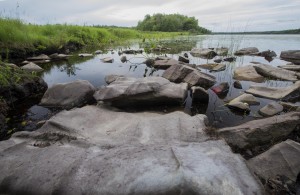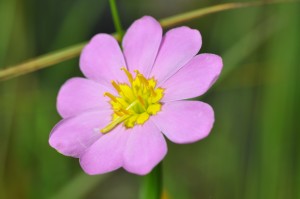 Quintessential Rare Plant Site Protected by Nature Trust
Quintessential Rare Plant Site Protected by Nature Trust
Wilsons Lake, N.S. (August 14, 2015) –A top priority site for Canadian endangered species conservation has been protected, forever, in Nova Scotia. The Nova Scotia Nature Trust announced today the successful acquisition of the 300 acres (122 ha) Wilsons Lake Conservation Lands, in Yarmouth County.
Southwestern Nova Scotia is home to a unique group of wetland plants known as Atlantic Coastal Plain Flora. Eleven of these plant species are on Canada’s endangered species list. They exist nowhere else in Canada. One property in particular has been a top conservation priority for decades, since the first discovery of these unique plants in Nova Scotia. That long-sought-after site has now been secured by the Nature Trust.
The Wilsons Lake Conservation Lands protect over 2.5 kilometers of lake shoreline, as well as forests, wetlands, and vernal pools important for frogs and other amphibians. Most significantly, the property includes extensive, intact shoreline habitat critical for four nationally endangered plants: the delicate and beautiful Pink Coreopsis and Plymouth Gentian, and the little but resilient Water Pennywort as well as Longs Bulrush.
All four endangered plants are found only in Nova Scotia, and only on a small number of lakes. They occur nowhere else in Canada. Plymouth Gentian (Sabatia kennedayana), in fact, grows in only three places in the world: A few lakes on the Tusket River, some ponds in Cape Cod and a few coastal rivers in the Carolinas, making its conservation here of global importance.
The Nature Trust’s conservation achievement is particularly timely and significant in light of increasing threats to the only surviving habitat; habitat that these species need for survival. Growing cottage and road development are damaging or destroying these last intact habitats.
For scientists and researchers, it is incredibly rewarding to see decades of scientific research, discovery and planning around these species and their habitats culminating in something so real, so tangible and lasting.
Dr. Paul Keddy, who completed the first systematic surveys of these rare wetlands plants in Nova Scotia, and devoted more than a decade of his career to their study, began advocating for their conservation in the 1970s. He was delighted to hear that one of Nova Scotia`s most outstanding Atlantic Coastal Plain Flora sites is now protected.
“The west shore of Wilsons Lake is one of the most outstanding examples of a coastal plain vegetation type in Canada. I say this having studied many coastal plain lakes in Nova Scotia and Ontario, having published numerous scientific papers on shoreline wetlands overall — and having canoed the length of the Tusket River in 1982. I use Wilsons Lake in my book, Wetland Ecology (2010, Cambridge University Press) to illustrate the importance of naturally fluctuating water levels for creating biologically diverse wet meadows. Hence, this property is not only significant for its many rare plants, but for the scientific principles which it exemplifies. Wilsons Lake is a perfect example of how conservation and scientific research complement one another.”
Beyond its own ecological significance, the Wilsons Lake Conservation Lands are part of a larger conservation vision and effort. The conservation community has long recognized the ecological significance of the entire Tusket River watershed. It has the highest diversity of these rare wetland species in Canada and is the only river with Pink Coreopsis and Plymouth Gentian. It truly is a globally significant river. The Nature Trust has been building contiguous shoreline corridor of protected rare plant habitat centered around the biodiversity hotspot on the river, Wilsons Lake. Such a corridor is critical to provide adequate habitat to truly protect these species, and the natural processes and systems required for their survival, over time.
The new Wilsons Lake Conservation Lands complete this conservation corridor. The site is bounded on the North by the Wilsons Lake Nature Reserve, and will ultimately become part of this provincially managed Nature Reserve. It also connects with the Nature Trust’s Jack and Darlene Conservation Lands, and land protected by the Nature Conservancy of Canada. With this critical gap filled, the conservation corridor now protects a total of 1110 acres (450 ha) of contiguous habitat, encompassing 11 kilometers of intact shoreline critical for these endangered species.
The Wilsons Lake conservation corridor itself is just one part of an even larger campaign focused on protecting the entire suite of 11 endangered wetland plant species of southwest Nova Scotia. Since 1998, the Nature Trust has been working with landowners, volunteers and local communities in southwest Nova Scotia to protect critical habitats for rare plants through land conservation, stewardship and education.
To date the Nature Trust has protected 11 conservation lands, encompassing 1200 acres (485 hectares) of critical habitat for endangered Atlantic Coastal Plain Species. These efforts build on the early work initiated by the Tusket River Environmental Protection Association, a local conservation organization that has been working to protect these species and habitats for 25 years. Other partners in research, conservation and stewardship of Atlantic Coastal Plain flora include the Province of Nova Scotia, Kejimkujik National Park, Acadia University, the Nature Conservancy, the Mersey Tobeatic Research Institute and the Atlantic Coastal Plain Flora Recovery Team.
According to Nature Trust Executive Director, Bonnie Sutherland, with some of Canada’s most endangered species finding refuge only here in Nova Scotia, their future is entirely in our hands. Today’s announcement brings good news on two fronts.
“Achieving the long-sought protection of this Wilsons Lake site brings three endangered species one more step back from the risk of extinction,” she noted. “But just as important, the longtime efforts of so many researchers, conservation partners, volunteers and donors that ultimately made this achievement possible demonstrates that Nova Scotians are truly committed as guardians of our unique natural legacy. That dedication inspires great hope for the future.”
There are many ways people can be a part of this conservation legacy, from participating in an educational field trip to the site, to volunteering as a Property Guardian, or donating to support the protection and long-term stewardship of the property.
The Nature Trust is hosting a free, guided walk into the new conservation lands this Saturday. For more information or to register contact nature@nsnt.ca or (902) 425-5263.
Part of the National Conservation Plan, this conservation project was undertaken with the financial support of the Government of Canada. Other major supporters include the Marguerite Hubbard Charitable Foundation, the Province of Nova Scotia, Gosling Foundation, McLean Foundation, Small Change Fund, Keurig, Banrock Station, Ascenta and many generous individual donors.
Charitable donations can be made online at www.nsnt.ca or by calling the Nature Trust at (902) 425-5263. The Nature Trust also accepts gift of securities and gifts by will. Learn more about the Nature Trust’s conservation programs and achievements at www.nsnt.ca.


